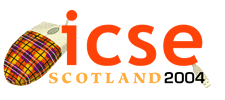
Panel 2 MDA in practise
Edinburgh International Conference Center, Scotland, UK Thursday 27th May 2004
Jean-Marc Jézéquel, IRISA (INRIA & University Rennes 1), Campus de Beaulieu, F-35042 Rennes, France, jezequel@irisa.fr
Wolfgang Emmerich, University College London, Department of Computer Science, Gower St., London WC1E 6BT, UK, w.emmerich@cs.ucl.ac.uk
Participants
Moderator
On its web site (www.omg.org)
the OMG gives its vision of MDA as follows:
MDA provides an open, vendor-neutral approach to the challenge of business
and technology change. Based firmly upon OMG's established standards,
MDA aims to separate business or application logic from underlying platform
technology. Platform-independent applications built using MDA and associated
standards can be realized on a range of open and proprietary platforms,
including CORBA, J2EE, .NET, and Web Services or other Web-based platforms.
Fully-specified platform-independent models (including behavior) can enable
intellectual property to move away from technology-specific code, helping
to insulate business applications from technology evolution, and further
enable interoperability. In addition, business applications, freed from
technology specifics, will be more able to evolve at the different pace
of business evolution.
A somehow less enthusiastic perspective is given by Martin Fowler:
Some people think that Model Driven Architecture (MDA) will be the
biggest shift in software development since the move from assembler to
the first high level languages. Others think that it's nothing more than
Night of the Living CASE Tools.
(martinfowler.com/bliki/ModelDrivenArchitecture.html)
Some of the ideas underlying MDA have indeed been around for many years,
from the failed promises of CASE in the late 1980's to more recent approaches
based on wizards or generative programming, or even Aspect Oriented Programming.
Because MDA gives a name and a conceptual framework to established practices, many people are realizing they were doing MDA without knowing it for many years, even if it is not exactly by the OMG's book. It is not a surprise then that many vendors claim to produce products that support MDA, and that more and more success stories are being publicized (who will the the first one to dare write a MDA unleached book?).
This panel will try to help clear the dust by examining the technologies and tools behind Model Driven Architecture, and assessing their novelty and interest. Specifically each of the following questions will by addressed by a renowned expert in the field:
* What is MDA in practice?
* What is it useful for? On its Web site the OMG claims that the top three benefits of the MDA to enterprises trying to cope with today's computing environment are:
o The MDA makes it easier to integrate applications and facilities across middleware boundaries.
o Domain facilities defined in the MDA by OMG's Domain Task Forces will provide much wider interoperability by always being available on a domain's preferred platform, and on multiple platforms whenever there is a need.
How has it been correlated in the field?
* Is MDA more than Night of the Living CASE Tools?
* Are there new software enginnering issues to consider with MDA?
* What is beyond the OMG's vision? How do other approaches such as Generative Programming or Aspect Oriented Software Development etc. fit to the overall picture of Model Driven System and Software Engineering?
Biographies
Patterns and MDA". Since 1990 he has been programming and designing
object-oriented systems, including object models, for companies such as
Credit Suisse First Boston and British Airways. A respected object-oriented
consultant, he has written and delivered training courses throughout Europe
and in America. Jim is a regular speaker at conferences such as Object World
and has been guest speaker at London Universities and the British Computer
Society.
Nicolas
Farcet is an architect in THALES and the manager of a research
programme called CARROLL (www.carroll-research.org). CARROLL was launched
in
early 2003 by THALES and French public research institutes CEA and INRIA.
This joint program aims at developing new software engineering and
middleware technologies. He also managed or contributed to various design
and development projects such as the OMG UML profile for CORBA Component
Model, a flexible middleware architecture based on .NET, a component-based
UML development methodology for Product Lines, a fault-tolerant middleware
based on CORBA. His current interest is on applying Web services and
Model-Driven Development technologies to Network Enabled Capability (NEC)
and large-scale Systems of Systems.
Nicolas
received a Dipl. Ing. degree in electrical engineering from ESIEE,
Paris, in 1994, and a PhD in computer science from University of Paris
6, in
1999. His PhD work was on the topic of space-based information filtering
in
large-scaled distributed 3D virtual environments.
adjunct professor of computer science at Carleton University in
Ottawa, Canada. He has over 30 years of experience in industry in designing
and implementing large-scale industrial software systems. He is the
principal author of a popular textbook that pioneered the application of
object technology and model-driven development methods in real-time
applications. He has published numerous papers on these and related topics in
various technical and scientific journals and conferences and is a
frequent invited speaker at such events. From 1996 onwards, he has
participated in the definition of the UML standard and its real-time UML
profile.
At present, he is leading an OMG team responsible for finalizing the UML 2.0
standard. Bran received his Dipl. Ing. degree in electrical engineering
and a Magister Ing. degree in systems theory from the University of Belgrade
in 1972 and 1974 respectively. He has been living and working in
Canada since 1977.